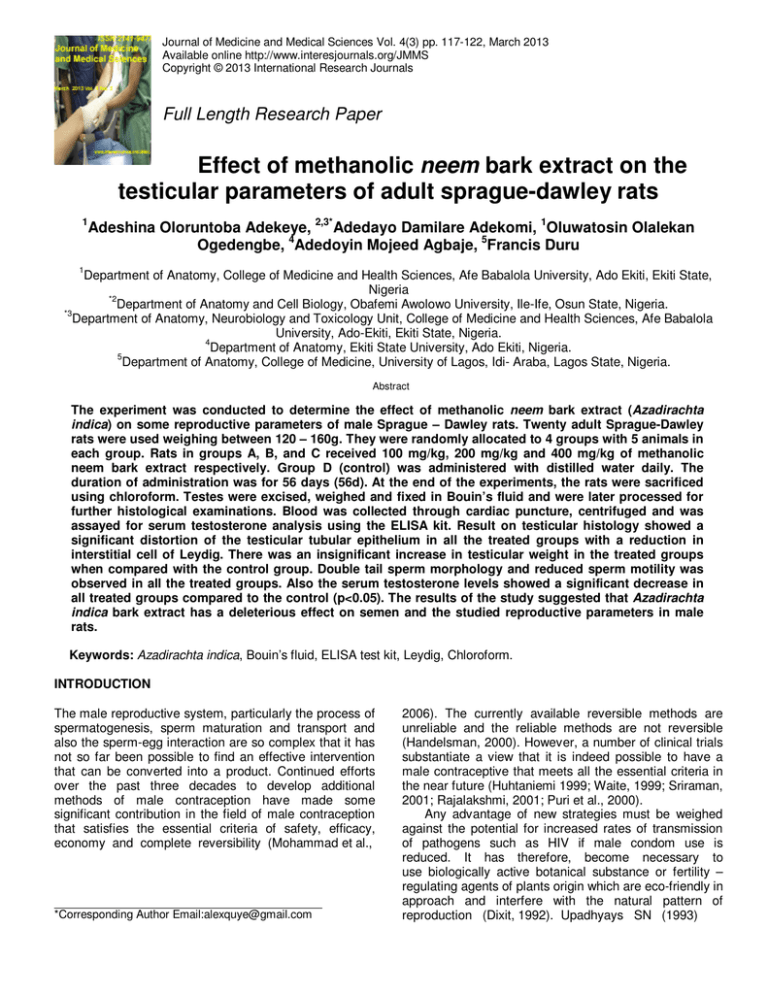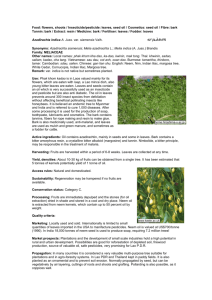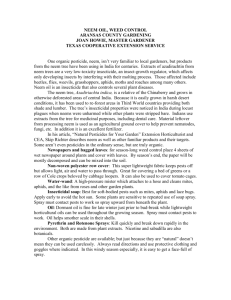Document 14233665
advertisement

Journal of Medicine and Medical Sciences Vol. 4(3) pp. 117-122, March 2013 Available online http://www.interesjournals.org/JMMS Copyright © 2013 International Research Journals Full Length Research Paper Effect of methanolic neem bark extract on the testicular parameters of adult sprague-dawley rats 1 Adeshina Oloruntoba Adekeye, 2,3*Adedayo Damilare Adekomi, 1Oluwatosin Olalekan Ogedengbe, 4Adedoyin Mojeed Agbaje, 5Francis Duru 1 Department of Anatomy, College of Medicine and Health Sciences, Afe Babalola University, Ado Ekiti, Ekiti State, Nigeria *2 Department of Anatomy and Cell Biology, Obafemi Awolowo University, Ile-Ife, Osun State, Nigeria. *3 Department of Anatomy, Neurobiology and Toxicology Unit, College of Medicine and Health Sciences, Afe Babalola University, Ado-Ekiti, Ekiti State, Nigeria. 4 Department of Anatomy, Ekiti State University, Ado Ekiti, Nigeria. 5 Department of Anatomy, College of Medicine, University of Lagos, Idi- Araba, Lagos State, Nigeria. Abstract The experiment was conducted to determine the effect of methanolic neem bark extract (Azadirachta indica) on some reproductive parameters of male Sprague – Dawley rats. Twenty adult Sprague-Dawley rats were used weighing between 120 – 160g. They were randomly allocated to 4 groups with 5 animals in each group. Rats in groups A, B, and C received 100 mg/kg, 200 mg/kg and 400 mg/kg of methanolic neem bark extract respectively. Group D (control) was administered with distilled water daily. The duration of administration was for 56 days (56d). At the end of the experiments, the rats were sacrificed using chloroform. Testes were excised, weighed and fixed in Bouin’s fluid and were later processed for further histological examinations. Blood was collected through cardiac puncture, centrifuged and was assayed for serum testosterone analysis using the ELISA kit. Result on testicular histology showed a significant distortion of the testicular tubular epithelium in all the treated groups with a reduction in interstitial cell of Leydig. There was an insignificant increase in testicular weight in the treated groups when compared with the control group. Double tail sperm morphology and reduced sperm motility was observed in all the treated groups. Also the serum testosterone levels showed a significant decrease in all treated groups compared to the control (p<0.05). The results of the study suggested that Azadirachta indica bark extract has a deleterious effect on semen and the studied reproductive parameters in male rats. Keywords: Azadirachta indica, Bouin’s fluid, ELISA test kit, Leydig, Chloroform. INTRODUCTION The male reproductive system, particularly the process of spermatogenesis, sperm maturation and transport and also the sperm-egg interaction are so complex that it has not so far been possible to find an effective intervention that can be converted into a product. Continued efforts over the past three decades to develop additional methods of male contraception have made some significant contribution in the field of male contraception that satisfies the essential criteria of safety, efficacy, economy and complete reversibility (Mohammad et al., *Corresponding Author Email:alexquye@gmail.com 2006). The currently available reversible methods are unreliable and the reliable methods are not reversible (Handelsman, 2000). However, a number of clinical trials substantiate a view that it is indeed possible to have a male contraceptive that meets all the essential criteria in the near future (Huhtaniemi 1999; Waite, 1999; Sriraman, 2001; Rajalakshmi, 2001; Puri et al., 2000). Any advantage of new strategies must be weighed against the potential for increased rates of transmission of pathogens such as HIV if male condom use is reduced. It has therefore, become necessary to use biologically active botanical substance or fertility – regulating agents of plants origin which are eco-friendly in approach and interfere with the natural pattern of reproduction (Dixit, 1992). Upadhyays SN (1993) 118 J. Med. Med. Sci. reported that male Wistar rats of proven fertility were given a single dose (50 µl) of neem oil in the luminal of the vas deferens on each side and deduce that all males treated with neem oil remained infertile throughout the 8 months of observation period. Among the option available for the regulation of male fertility, disruption of sperm transport in the vas deferens is an attractive one. It is known that the accessory sex organ such as epididymis and vas deferens are androgen dependent target and manifest differential sensitivity to androgens for maintenance of their structure and function (Khan and Awasthy, 2003). It is also known that any change in circulating androgens would affect the internal microenvironment of epididymis and thereby lead to alteration sperm motility and metabolism (Khan and Awasthy, 2003). Vasectomy is the only available method of male contraception adopted world wide in family welfare programmes despite that it is a permanent surgical procedure and its successful reversal is not assured (WHO, 1983). Neem (Azadirachta Indica) is the most versatile tree ever found which a native of Indian subcontinent is. It is a highly esteemed tree and has been closely associated with the socio-cultural and religious aspects of Indian life science ancient time. Various raw materials can be gotten from neem which include neem leaves, neem seeds, neem bark, neem fruit, neem flower, neem twig, neem gum, neem root and neem kernel. The actions of neem include antipyretic (fever-reducing), alterative (produces gradual beneficial change in body; antihelmintic (dispels parasites), antiseptic (destroys bacteria) and bitter tonic (strengthens the organism). Recently, many laboratories are engaged in developing a male contraceptive from plants. (Mohammed, 2006). Plants product as contraceptive will be more acceptable for economic reasons in terms of self-reliance and the possible practicability studies on the effect of plant product on male reproductive system and fertility are comparatively few. The importance of the neem tree has been recognized by US National Academy of Science which published a report in 1992 entitled “Neem – a tree for solving global problems (Upadhyay et al., 1993). It is therefore of interest to evaluate the effective concentration of methanolic extract of botanical neem bark on potential reproductive sites of Sprague-Dawley male rats. MATERIALS AND METHODS Collection of Plant and Preparation of Plant Extracts Fresh neem bark (2.62 kg) was collected from a forest in Lagos and authenticated by a taxonomist in the Department of Botany, University of Lagos, Nigeria. The bark were air-dried at room temperature. The dried bark material were measured using Gallenkomp (FA2104A, England) electronic weighing balance and pulverized with Blender/Miller III, (model MS -223, China). Sixty grams of the pulverized bark sample were later soaked in methanol (1:1, by volume) in a separating funnel plugged with cotton wool. It was drained after twenty-four hours and rewashed with more of the solvent. The filtrate was poured in an evaporating dish and placed on a water bath at 35ºC, and reduced pressure (45% atmospheric pressure) to remove the solvent. After all the solvent had evaporated, the extract was scrapped and stored in a dry glass container at a temperature of 0 – 4ºC. Animal Care and Treatment Twenty male Sprague Dawley rats weighing 120 – 180 g were housed in a controlled environment and given free access to standard rat chow and distilled drinking water. This experimental investigation was done in accordance with the standard humane animal care as outlined in the “Guide for the care and use of Animals in research and teaching”, as approved by the Institute of Laboratory Animal Resource, National Research Council, DHHS, Pub. No NIH 86 – 23 (NIH, 1985). The rats (five in each group) were divided into four (4) groups designated as A, B, C (respective treatment groups) and D (control group). The rats in group A were treated with 100 mg/kg of methanolic neem bark extract, rats in group B were treated with 200 mg/kg of the extract, rats in group C were treated with 400 mg/kg extract while rats in group D were treated with distilled water but not neem extract. Animal Sacrifice The rats were sacrificed 24hrs after the last administration. The rats were placed inside a flask containing chloroform. The testes were removed. The right testes were used for the histological study. These were fixed in Bouin’s fluid for 24 hrs after which it was processed for further histological examination using H&E stain. The left testes were used to study sperm morphology and motility. Serum Biochemical Analysis Blood was obtained by cardiac puncture from the rats in each study group to determine the serum testosterone level. Each blood sample was centrifuged at 250 rpm for 10 minutes in a desktop centrifuge to obtain the serum from the whole blood. The serum was then assayed for serum testosterone analysis. The serum sample was assayed for testosterone level using the enzyme linked immunoassay (ELISA) technique. Oloruntoba et al. 119 Semen Collection and Analysis The caudal epididymis of each rat was removed and minces manually into several pieces. These were placed in sterile specimen bottle containing 1.0 ml of normal saline for about 5 min to allow sperm to become motile. The semen was taken from the specimen bottle with 1.0 ml pipette and dropped on a clean slide covered with cover slips. The slides were placed under light microscope and view sperm morphology and motility. Sperm motility was assessed using the WHO classification system (WHO, 1999). Each sample was assessed twice. For consistency, all reading was carried out at 37°C (WHO, 1999). of the seminiferous tubule and widening of the interstitial space with reduction of interstitial cells of Leydig (Figure c). From the table 1 and 2, sperm count of rats in groups (A-C) treated with neem bark extract decreased insignificantly with values ranging from 173 millions per milliliter – 150 millions per milliliters when compared to that of the rats in the control group. The sperm motility in group A that received 100 mg/kg of neem bark extract decreased slightly while at higher doses of 200 mg/kg and 400 mg/kg of neem bark extract in group B and group C respectively resulted in statistically significant decrease. DISCUSSION Statistics The data obtained from all the groups were compiled and statistically analyzed using ANOVA method. The results of the data were expressed as mean ± SEM. RESULTS Using the Olympus binocular light microscope (XSZ107BN, Nọ. 071771) for the histological observation of the testicular tissue samples obtained from the rats in the control group treated with distilled water, it was observed that the histological architecture was preserved. The seminiferous tubule; is represented by circular and oval profiles, closely packed and uniformly spaced with lumen containing numerous spermatids (Figure 1d). Clear histological observation of the testes of the rats treated with 100 mg/kg methanolic neem bark extract is presented in Figure 1a. The epithelium of the seminiferous tubules is fairly stratified and organized with all cells of the spermatogenic series present. The sertoli cells are well perforated with smaller interstitial space. The tunica albuginea is normal but there is a reduction in the population of the Leydig cells. The light microscopic examination of the testicular tissues of the rats treated with 200 mg/kg methanolic neem bark extracts as seen in Figure b displayed reduction of interstitial cell of Leydig with some congestion of blood vessels in the stroma. Also there was distortion of the epithelium in the seminiferous tubule. The interstitial spaces between the seminiferous tubules were not uniformly spaced. The microscopic examination of the processed testicular tissues of the rats treated with 400 mg/kg of methanolic neem bark extract has deleterious characteristic and these include; the tunica albuginea separated from seminiferous epithelium, congestion of blood vessel in the stroma, distortion in the appearances The results of this study showed that neem bark extract has a deleterious effect on histological changes of the testis and a significant increase in frequency of sperms with double tail morphology was observed. It also showed that sperm motility was significantly reduced after 56 days in the treated groups as compared with the control group although decreased in mean sperm count was statistically not significant. Sperm motility reduction plays a major role in neem as a contraceptive effect without altering the process of spermatogenesis (Randhwa, 1996). It is also known that any changes in circulating androgen would affect the internal microenvironment of the testis and thereby lead to alteration in sperm motility and metabolism (Upadhyay et al., 1993). Most of the spermatozoa were lacking in progressive motility and sluggishly motile or stationary with movement of tail indicating that Azadirachta indica bark extract interfered with sperm motility. There was general insignificant increase in body weight of treated groups which is probably due to their androgenic properties since androgen posses’ anabolic activities (Johnson and Everitt, 1988). These obtained results also revealed that extract did not affect body and organ weights of the testis which indicate that the extract did not promote body weight gain to cause obesity (Mohammed et al., 2006). Serum testosterone level decreased significantly when compared with the control group. These decreases might be as a result of drastic reduction of interstitial cell of Leydig in all the treated groups. In addition, studies of various forms of neem for male contraception in different types of mammals have reported no changes in libido or hormonal function (Jensen, 2002). Neither neem leaf extract in water nor neem leaf oil alters the rate of spermatogenesis but the contraceptive effect of these two forms of neem comes from a reduction in the motility of the sperm with a decrease in the number of Leydig cells (Randhawa, 1996). Testicular function suppression as evident by reduced sperm motility, cell vacuolation and edema of the 120 J. Med. Med. Sci. Figure 1. Photomicrograph of the testes of rats in groups A-D Table 1. Table of sperm count (x106 / ml) with mean and standard error of mean GROUP n=5 Group 1 Group 2 Group 3 Group 4 (Control) TREATMENT (days) 56 56 56 56 SPERM COUNT (Million /mL) 150 ± 23.12 120 ± 15.29 173.33 ± 14.54 176.67 ± 17.66 Oloruntoba et al. 121 Table 2. Table of sperm motility (%) with mean and standard error of mean GROUP n=5 Group 1 Group 2 Group 3 Group 4 (Control) TREATMENT (days) 56 56 56 56 SPERM MOTILITY (%) 74 ± 3.67 36 ± 6.96 20 ± 4.18 81 ± 3.37 Data is expressed as mean ± SEM. Statistical analysis involve the use of t-test (p < 0.05) Table 3. Changes in body and testicular weight after treatment for 56 days GROUP n=5 Group 1 Group 2 Group 3 Group 4 INITIAL WEIGHT (g) 130 ± 3.54 132.8 ± 2.10 157.20 ± 4.88 171.25 ± 4.27 FINAL WEIGHT 204.67 ±10.37 193.17 ±3.03 224.83 ±11.62 232.83 ±14.08 BODY WEIGHT DIFFERENCE (g) 74.68 60.37 68.00 61.59 % INCREASE 57.44 45.46 43.26 35.96 TESTICULAR WEIGHT (g) 1.00 ± 0.00 1.13 ± 0.007 1.03 ± 0.03 1.00± 0.11 HORMONAL ASSAY Table 4. Biochemical changes in the teatis (serum testosterone level) after treatment for 56 days GROUP n=5 Group 1 Group 2 Group 3 Group 4 (Control) TREATMENT DAYS 56 56 56 56 SERUM TESTOSTERONE LEVEL (ng/mL) 0.88 ± 0.02 0.65 ± 0.02 0.55 ± 0.02 1.98 ± 0.02 Data is expressed as mean ± SEM. Statistical analysis involve t-test (p < 0.05). stroma will lead to reduced fertility (Kusemiju et al., 2012). CONCLUSION The result obtained in this study show that neem bark extract has a deleterious effect on the sperm motility, serum testosterone level and interstitial cell of Leydig. Sperm motility and testosterone levels are reduced although sperm count, body and testicular weight are essentially normal. Finally, treatment with neem bark extract potentially has a deleterious effect on reproductive health of adult male Sprague-Dawley rat. REFERENCES Dixit VP (1992). Plant products/ non- steroidal compounds affecting fertility in the Indian Desert Gerbil, meriones Hurriance Jerdon. In: prakash 1 and Ghosh PK (Editors). Rodents in Indian Agriculture, Scientific Publisher, Jodhpur, Indian:595- 604. Gbotolorun SC, Osinubi AA, Noronha CC, Okanlawon AO (2008). Antifertility potentential of neem flower extract on adult female Sprague-Dawley rats. Afri. Health Sci. J.8(3):168-73. Gorgas k, Bock P (1974). Myofibroblast in the rat testicular capsule. Cell tissue. Res.; 154:533-541. Handelsman, D.J (2002). Hormonal male contraception, Int. J. Androl.; 23:8-12. Huhtanienmi I (1999). Current challenges of Andrology. Asian J. Androl.; 1:3-5. Jensen JT (2002). Male Contraceptive. Current Women Health Rep, 2:338-345. Khan PK, Awasthy KS (2003). Cytogenic toxicity of neem. Food Chemistry Toxicol;41:1225-1328. Kusemiju TO, Yama OE, Okanlawon AO (2012). Effect of Carica papaya bark extract on oxidative stress parameters in testes of male albino rats; Int. J. Appl. Res. Nat. Prod. 4(4):1-6 Majumdar AM, Upadhya AS, Pradhan AM (1998). Effect of Azadirachta Indica leaf extract on carbontetrachloride induced hepatic galvage in albino rats. Ind. J. Pharm. Sci. 60(6):363-367. Manikandan P, Letchoumy PV, Gopalakrishnan M, Nagini S (2008). Evaluation of Azadirachta Indica leaf fractions for in vivo antioxidant potential and in vivo modulation of biomarkers of chemoprevention in the hamster buccal pouch carcinogenesis model. Food and Chem. Toxicol.;46(7):2332-42 Mohammed HD, Ahmad D, Dehghanan R (2006). Histological Evidence of male potent Reproductive sites by Iranian Botanical Azadirachta 122 J. Med. Med. Sci. indica (Neem) seed Extract. Int. J. Mol. Med. Adv. Sci.; 2(1):7-15. Okanlawon AO, Noronha CC, Ashiru AO (1990). The effect of testosterone gonadotropin and sperm motility. W. Afri. J. Pharm. Drug Res. 31-33. Orgebin Crist, MC, Danso BJ, Davies J (1975). Endocrine control of the development and maintenance of sperm fertilizing ability in the epididymis. In Hamilton Div. Greep Ro (eds), Handbook of Physiology of Washington DC, American Physilogical Society pp319338. Puri CP, Gopalkrishnan K, Iyer KS (2000). Constraints in the development of contraceptives for men. Asian J. Androl.;3:179-190. Rahdhawa NA, Parmar BS (1996). Neem in New Age International: New Delhi, India.




